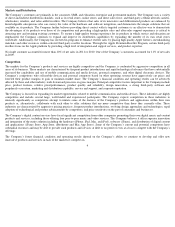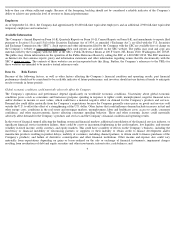Apple 2011 Annual Report Download - page 18
Download and view the complete annual report
Please find page 18 of the 2011 Apple annual report below. You can navigate through the pages in the report by either clicking on the pages listed below, or by using the keyword search tool below to find specific information within the annual report.
import and export requirements, anti-corruption, foreign exchange controls and cash repatriation restrictions, data privacy requirements, anti-
competition, environmental, health, and safety.
By way of example, laws and regulations related to mobile communications and media devices in the many jurisdictions in which the Company
operates are extensive and subject to change. Such changes could include, among others, restrictions on the production, manufacture,
distribution, and use of the device, locking the device to a carrier’s network, or mandating the use of the device on more than one carrier’
s
network. These devices are also subject to certification and regulation by governmental and standardization bodies, as well as by cellular
network carriers for use on their networks. These certification processes are extensive and time consuming, and could result in additional testing
requirements, product modifications, delays in product shipment dates, or preclude the Company from selling certain products.
Compliance with these laws, regulations and similar requirements may be onerous and expensive, and they may be inconsistent from jurisdiction
to jurisdiction, further increasing the cost of compliance. This increases the costs of doing business, and any such costs, which may rise in the
future as a result of changes in these laws and regulations or in their interpretation could individually or in the aggregate make the Company’
s
products and services less attractive to the Company’
s customers, delay the introduction of new products in one or more regions, cause the
Company to change or limit its business practices, or affect the Company’
s financial condition and operating results. The Company has
implemented policies and procedures designed to ensure compliance with these laws and regulations, but there can be no assurance that the
Company’s employees, contractors, or agents will not violate such laws and regulations or the Company’
s policies. Any such violations could
individually or in the aggregate materially adversely affect the Company’s financial condition or operating results.
The Company’s success depends largely on the continued service and availability of key personnel.
Much of the Company’
s future success depends on the continued availability and service of key personnel, including its CEO, its executive team
and highly skilled employees. Experienced personnel in the technology industry are in high demand and competition for their talents is intense,
especially in the Silicon Valley, where most of the Company’s key personnel are located.
Political events, war, terrorism, public health issues, natural disasters and other circumstances could materially adversely affect the Company.
War, terrorism, geopolitical uncertainties, public health issues, and other business interruptions have caused and could cause damage or
disruption to international commerce and the global economy, and thus could have a strong negative effect on the Company, its suppliers,
logistics providers, manufacturing vendors and customers, including channel partners. The Company’
s business operations are subject to
interruption by natural disasters, fire, power shortages, nuclear power plant accidents, terrorist attacks, and other hostile acts, labor disputes,
public health issues, and other events beyond its control. Such events could decrease demand for the Company’
s products, make it difficult or
impossible for the Company to make and deliver products to its customers, including channel partners, or to receive components from its
suppliers, and create delays and inefficiencies in the Company’
s supply chain. Should major public health issues, including pandemics, arise, the
Company could be negatively affected by more stringent employee travel restrictions, additional limitations in freight services, governmental
actions limiting the movement of products between regions, delays in production ramps of new products, and disruptions in the operations of the
Company’s manufacturing vendors and component suppliers. The majority of the Company’
s research and development activities, its corporate
headquarters, information technology systems, and other critical business operations, including certain component suppliers and manufacturing
vendors, are in locations that could be affected by natural disasters. In the event of a natural disaster, losses, significant recovery time and
substantial expenditures could be required to resume operations and the Company’
s financial condition and operating results could be materially
adversely affected.
16
























